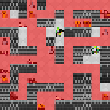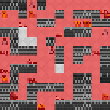Information Technology Reference
In-Depth Information
when faced with new situations. Indirect imitation to a large extent solves this
problem by learning a more robust, general strategy, which could be termed a
decision making style. In the following section we give a brief introduction to our
test bed game.
3
MiniDungeons
The testbed game, MiniDungeons, implements the fundamental mechanics of a
roguelike dungeon exploration game where the player navigates an avatar through
a dungeon containing enemies, powerups, and rewards. The turnbased game puts the
player in a top-down viewed tilebased 12 by 12 dungeon con- taining monsters,
potions, and treasures. Impassable tiles constitute the walls of the dungeon, while
passable tiles contain enemies or items for the player. All of the level is visible to
the player who can move freely between passable tiles. When the player moves to
a tile occupied by a monster or item, immediately the monster is fought or the item
is collected and applied. The player has a 40 hit point (HP) health counter and dies
if this drops to zero. Monsters randomly deal between 5 and 14 HP of damage
while potions heal 10 HP up to the maximum value of 40 HP. Treasures have no
game mechanical effect other than adding to a counter of collected treasure. The
game contains one tutorial level and 10 “real” levels. For further details on the
test-bed game and discussion of its properties, we refer to [6]. The necessary
data for developing and evaluating the agents was collected from 38 anonymous
users who played MiniDungeons online; this re- sulted in 380 individual playtraces
on the 10 MiniDungeons levels provided. The data was subsequently used to
evolve clones and baseline agents as described be- low. Fig. 1 shows a selected
level from the game, along with human play traces from the level, exemplifying
the diversity of human decision making styles ex- pressed in even a simple game
like this.
Fig. 1.
Heatmaps of six selected human playtraces in Level 2 of MiniDungeons, showing a
diversity of player decision making styles
4
Method
This section describes the two agreement ratio metrics used to evaluate persona
and clone likeness to humans, the fitness functions for personas and clones, and
the evolutionary approach used. The metrics address the problem of decision
characterization at two different levels of abstraction.






